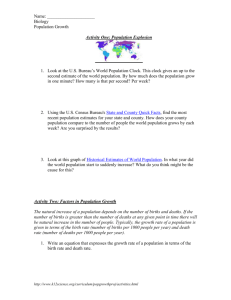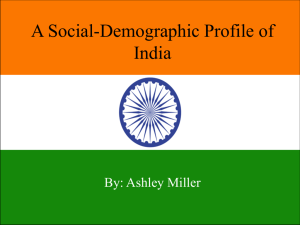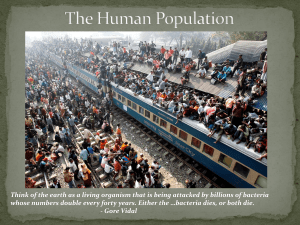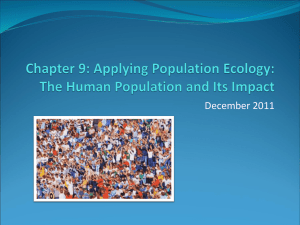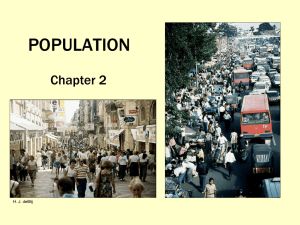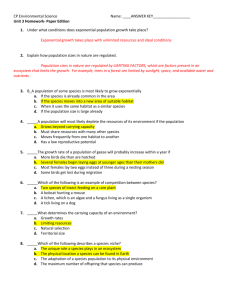Understanding Our Environment
advertisement
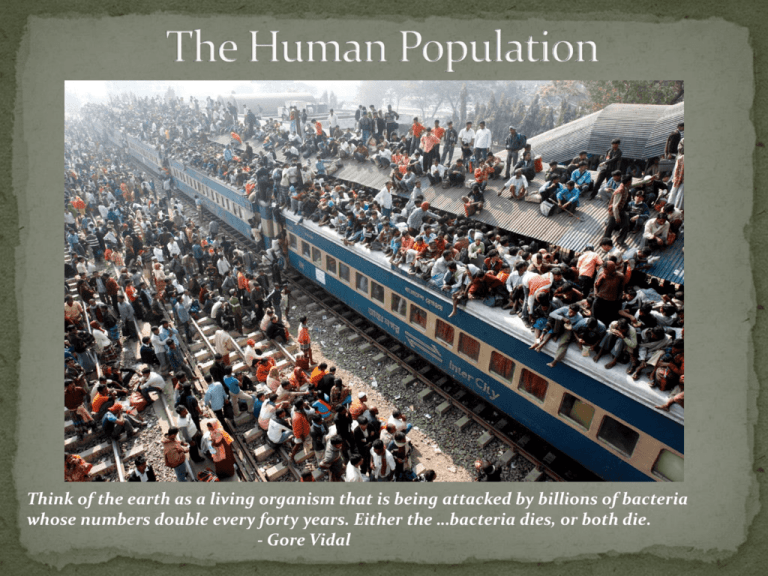
Think of the earth as a living organism that is being attacked by billions of bacteria whose numbers double every forty years. Either the …bacteria dies, or both die. - Gore Vidal The evolution of Homo sapiens and a total population of about 2 billion took about 200,000 years In 2015, the World population reached 7.3 billion people It’s estimated that there will be 2.5 billion more people by 2050 Are there too many people already? Will technological advances overcome environmental resistance that populations face? Should populations be controlled/limited? During the earliest parts of human history, our population survived as hunter-gatherers. The population during this time was low; estimated to be in the thousands. Like other species, population size was limited by environmental resistance factors, such as competition for food and water, predators, and disease. 3 At some point, estimated to be about 130,000 years ago, Homo sapiens migrated out of Africa into what would become the fertile crescent. 4 The fertile crescent, as a “bridge” between Africa and Eurasia, had an unusually high amount of biodiversity. The eight “founder crops,” including wild ancestors to modern flax, wheat, barley, and lentils, grew here. The ancestor species of four out of the five modern domesticated livestock animals were native to here. 5 The presence of two major river systems also stimulated the invention of irrigation. This period is known as the Agricultural Revolution and marked the first point where humans moved from a nomadic lifestyle to settling in towns and villages. Instead of hunting and gathering, humans began growing and raising their own food supply. 6 Agriculture gave humans a greater degree of control over their food supply. As a result, the population began to grow. 7 The human population grew at a steady rate, reaching about 800 million by 1800 A.D. Some density-dependent limiting factors were still in place. Famines Western Europe, 400-800 A.D. Mayan Civilization, 800-1000 A.D. Little Ice Age, 17th century Great Potato Famine (Ireland), 1845-1847 Disease Malaria (10,000 B.C.-present), cause of about half of all human deaths Black Plague (14th century), Eliminated 1/3 of Europe’s population. 8 The industrial revolution began a multitude of new technologies and innovations. Electricity The steam engine Water treatment Antibiotics Vaccines The overall impact was a massive drop in infant mortality – the death rate in newborns. This led to an increase in overall average life expectancy. Pre-industrial life expectancy in Britain was 25-40 years. Current life expectancy worldwide is 67 years. 9 World Population “Dots” Video. Population Connection, 2003. Industrialized farming, water treatment, and modern medicine removed many densitydependent limiting factors. The human population began to grow exponentially. 11 Planet Earth: Population 7.3 Billion Billions of people 2011 (7 billion) 1999 (6 billion) 1987 (5 billion) 1974 (4 billion) 1960 (3 billion) 1930 (2 billion) 1800 (1 billion) Time Hunting and gathering Agricultural revolution Industrial revolution Fig. 6-1, p. 122 Exponential growth occurs when the population size and its rate of growth both increase. It took over 70,000 years to reach 1 billion. 150 years to reach 3 billion. 25 years to reach 4 billion. 20 years to reach 5 billion 12 years to reach 6 billion. 11 years to reach 7 billion. 13 Another way of measuring growth is through doubling time, an estimate of how long it will take the population to double in size at its current rate of growth. Doubling time is calculated with this equation: 70 / (Current % Growth Rate) Year 1970 1980 1990 2000 2010 Growth Rate Doubling Time 2.09 34 years 1.82 38 years 1.60 44 years 1.26 56 years 1.12 63 years 14 Demographics is the study of human populations. Includes comparing statistics such as births, deaths, gender, race, and economic status. Developing countries have populations that tend to be poorer, younger, and are growing much more rapidly. Developed countries are wealthy, old, and tend to have decreasing population sizes. 15 Population change = (births + immigration) – (deaths + emigration) Crude birth rate The number of live births/1000/year Crude death rate The number of deaths/1000/year NATURAL CAPITAL DEGRADATION Altering Nature to Meet Our Needs Reduction of biodiversity Increasing use of the earth's net primary productivity Increasing genetic resistance of pest species and disease-causing bacteria Elimination of many natural predators Introduction of potentially harmful species into communities Using some renewable resources faster than they can be replenished Interfering with the earth's chemical cycling and energy flow processes Relying mostly on polluting and climatechanging fossil fuels Fig. 6-A, p. 124 Developing countries contain 80% of the world’s population, and will account for 90% of its projected growth. 19 12 11 High 10.8 10 Population (billions) 9 Medium 9.3 8 7 6 Low 7.8 5 4 3 2 1950 1960 1970 1980 1990 2000 2010 2020 2030 Year 2040 2050 Fig. 6-2, p. 125 Comparing developed and developing countries requires the use of these demographic variables: Life expectancy, or how long an average newborn will live in a society. Most affected by infant mortality rate. The total fertility rate, the average number of children a woman will have in her lifetime. A fertility rate above replacement level, 2.1, will generally result in a growing population. Below replacement level results in a shrinking population. Gross domestic product per capita is a measurement of standard of living. Total value of all goods and services produced in a country per person. 21 Country GDP Per Capita Total Fertility Rate Life Expectancy United States $49,965 1.89 78.6 Afghanistan $620 6.16 48.7 Afghan market. Photo by Staff Sgt. Russell Lee Klika 22 Life expectancy (and infant mortality) are highly correlated with GDP, up to about $4000/year. 23 47 years Life expectancy 77 years Married women working outside the home 8% 81% 15% High school graduates 83% 10% Homes with flush toilets Homes with electricity Living in suburbs Hourly manufacturing job wage (adjusted for inflation) Homicides per 100,000 people 98% 2% 99% 10% 52% $3 1900 2000 $15 1.2 5.8 Stepped Art Fig. 6-7, p. 132 The movement of individuals between areas can have a major impact on population change. Emigration is when people move out of an area. More likely to occur in developing countries. Immigration is when people move into an area. More likely to occur in developed countries. 26 In some developed countries, immigration offsets or delays the normal population decline. The United States total fertility rate in 2011 was 1.89, below replacement level. The overall immigration was over 11 million. The population growth rate was 0.7%. Japan had a fertility rate of 1.39 in 2011. The overall immigration was just over 200,000. Their population growth rate is -0.2%. 27 Children as part of the labor force Cost of raising and educating children Availability of private and public pension Urbanization Educational and employment opportunities for women Average age of a woman at marriage Infant mortality rates Availability of legal abortions Availability of reliable birth control methods Religious beliefs, traditions, and cultural norms Children as part of the labor force Cost of raising and educating children Availability of private and public pension Urbanization Educational and employment opportunities for women Life expectancy - the average # of years an infant can expect to live Infant mortality rate: The infant mortality rate (IMR) is the number of deaths of infants under one year old, per 1,000 live births. High infant mortality rate indicates: Inadequate health care for poor women during pregnancy and their infants (poverty) Drug addiction among pregnant women High birth rate among teenagers Infant mortality rate (deaths per 1,000 live births) Less-developed countries World More-developed countries Year Fig. 6-10, p. 129 Why are people living longer and fewer infants dying? Increased food supply and distribution Better nutrition (less malnutrition and undernutrition) Medical advances Improved sanitation When studying the demographics of a single country, two of the most important factors to examine are gender and age distribution. These variables are graphed as population pyramids, and can provide valuable insight into a country. 32 What is the overall shape of the graph? Is there a dominant age group or groups? What proportion of the 0-4 age group survives into the elderly (60+) age groups? Are the male and female sides roughly equal? 33 The fertility rate and population growth patterns in a given country will not remain constant. They change based on a wide variety of factors. United States Fertility Rates, 1911-2011 35 Pronatalist pressures increase the likeliness of individuals within a population to have more children. Source of pleasure, pride, comfort. Source of support for elderly parents. Aid in supporting family income. Counteracting high child mortality rates. Social status – importance of having a son. Most antinatalist pressures involve women. Higher education and personal freedom. More opportunities to earn a salary. Higher socioeconomic status. 36 Countries will typically pass through a series of stages as they industrialize and transition from developing to developed countries. During the pre-industrial stage, food shortages, malnutrition, poor sanitation, and lack of access to modern medicine keep death rates high. All regions of the world were in this stage up until the industrial revolution. 37 During the early transition stage, access to food and medicine improves, leading to a rapid drop in death rates. Birth rates remain high, as family size is tied to cultural norms and religious beliefs. Population size begins to increase exponentially. 38 During the late transition stage, efforts are made to reduce birth rate. Birth control and sex education gain greater acceptance. Women play a greater role in family planning. The population continues to increase, but more slowly. 39 During the industrial stage, birth rates have fallen back into balance with death rates. Total fertility rate is close to replacement level. The population stabilizes. 40 During the post-industrial stage, birth rates continue to fall due to antinatalist pressures Total fertility rate is below replacement level. The population size decreases. 41 42 Some Problems with Rapid Population Decline Can threaten economic growth Labor shortages Less government revenues with fewer workers Less entrepreneurship and new business formation Less likelihood for new technology development Increasing public deficits to fund higher pension and health-care costs Pensions may be cut and retirement age increased Fig. 6-11, p. 133 Most demographers believe the world population will stabilize sometime during the next century. Projections of Low Medium High maximum population size: 8 9.3 13 billion billion billion 45


